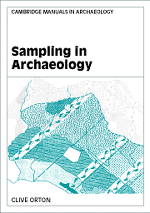Book contents
- Frontmatter
- Contents
- List of illustrations
- List of tables
- Acknowledgements
- 1 All the world's a sample
- 2 A little of what you fancy?
- 3 If this is the sample, what was the population?
- 4 Covering the ground
- 5 What's in a site?
- 6 The answer lies in the soil
- 7 ‘But many sanguine people hope, to see them through a microscope’
- 8 ‘In its depths, what treasures’
- 9 Beyond random sampling
- Appendix
- Bibliography
- Index
2 - A little of what you fancy?
Published online by Cambridge University Press: 05 June 2012
- Frontmatter
- Contents
- List of illustrations
- List of tables
- Acknowledgements
- 1 All the world's a sample
- 2 A little of what you fancy?
- 3 If this is the sample, what was the population?
- 4 Covering the ground
- 5 What's in a site?
- 6 The answer lies in the soil
- 7 ‘But many sanguine people hope, to see them through a microscope’
- 8 ‘In its depths, what treasures’
- 9 Beyond random sampling
- Appendix
- Bibliography
- Index
Summary
A brief history of statistical sampling theory
The origins of the fundamental idea of sampling, that a small part can in some way be taken to represent, or stand in for, the whole, are lost in the origins of civilisation itself. There are many everyday, and especially commercial, situations in which the need for sampling, however informal, would have asserted itself. For example, merchants buying grain would wish to test the quality of their purchases, or a community would wish to maintain the standards of the weights and measures of goods (e.g. bread, ale) being sold within it. Such checking is at best time consuming and at worst destructive of the material being checked. For purely practical reasons, a small part had to stand in for the whole. Of course, such a procedure must be seen to be ‘fair’, to both the producer and the consumer, and this need must have been a frequent cause of disputes. In the absence of any appropriate theory, trust in whoever was doing the checking must have been important, and procedures similar to what we would today call random selection (see below) may have grown up.
Later, in the eighteenth and especially the nineteenth century, the need for sampling was felt in other areas, like scientific research and economic and social policy, and more theoretical questions began to be asked.
- Type
- Chapter
- Information
- Sampling in Archaeology , pp. 14 - 39Publisher: Cambridge University PressPrint publication year: 2000



